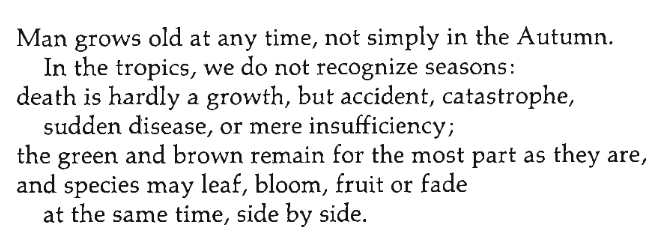Articles/Essays – Volume 09, No. 1
September the First, 1969
Man grows old at any time, not simply in the Autumn.
In the tropics, we do not recognize seasons:
death is hardly a growth, but accident, catastrophe,
sudden disease, or mere insufficiency;
the green and brown remain for the most part as they are,
and species may leaf, bloom, fruit or fade
at the same time, side by side.
In England, the seasons are blurred by weather—
the weather here persisting
as a cross-pattern of seasons in little;
so that we pass from life through death to resurrection
in a day or part of one, our process always before us.
We cannot readily tell the first of January—
it might be November, March,
or even, sometimes, early April;
but we do know
within a sennight or so,
when harvest will be at an end;
and trees that leaf in May are barely left in October.
In Sweden, it is easier to remember your age:
you enter a Dalecarlian Church
on a bright-twigged, May Sunday morning
to come out under an avenue of already opened buds;
and a Norrland August
with apricot birches against an evergreen background
leaves you in no doubt.
For the Elburz or the Wasatch
—half a world apart and most of history,
they look much alike—
snow and thaw have an appointed programme:
I have noted date, height, and encroachment or retreat.
The Himalayan flanks are embroidered with climates and seasons,
through which, with increasing risk, you clamber up
to a sort of wintry liberation
—or possession—
at an ecstatically disappointing summit:
below, the wrinkled limbs of the world; above
a usual sun-and-air illusion of blue,
or by night
the customary dust of tinsel and a make-believe medal
—a tarnished button that has lost its fastener—
left scattered—for how many thousand million years?
their estimate grows longer every decade—
on the bottom of an otherwise empty drawer
in an inconceivable tallboy
in an unimaginable attic
in a house
(change the scale, but not the metaphor—
if it were not so, He would have told us)
of many mansions.
Even when thinking of death we are hardly concerned
with absolute zero, the speed of light, or extremes
of large and small where shape and meaning seem
to vanish;
we prefer to envision a temperate, seasoned landscape
of growth, decay, and resurrection,
visited at times by the Gods and their candid angels,
and fit—on return to its pristine state—
for the life to come as well as this present existence.
It is true that, in such a landscape,
a man may grow old at any time; but in Autumn,
carting the crop or ploughing up the stubble,
he feels himself young with labour and rejoices
—like Constable
in his picture of the stag, the memorial stone
and the turning beech leaves—
at the emptiness,
dryness,
and lightness
of the final approach.
But this is the first day of the year—
the Church’s year, the Father’s,
the year of His chosen people.
(It also happens to be Labor Day.)
The burden of the winter corn has been cleared away,
the rest of the harvest is gathering,
and the implication on the Janus face
of the grain-or-plain chequerboard
is comfortingly platitudinous: in the end, fulfilment;
in the beginning, space.
September space: a middle-aged heavy
moves light and youthful at the thought of death
and its initiation
certainly not into rest, the reverse of virtue,
but into the second Paternal gift
consequent upon that first and principal talent of caritas:
hard, fresh work.


 Back to full Issue
Back to full Issue

